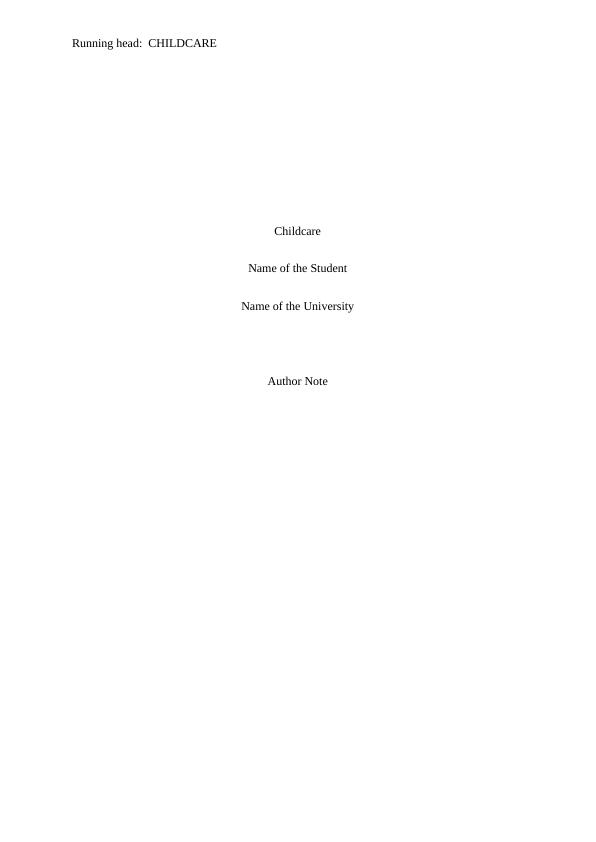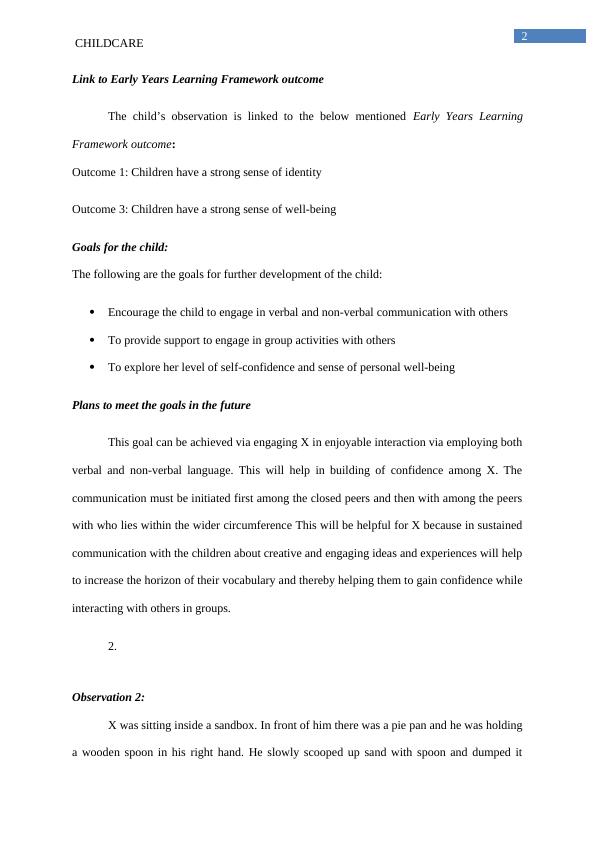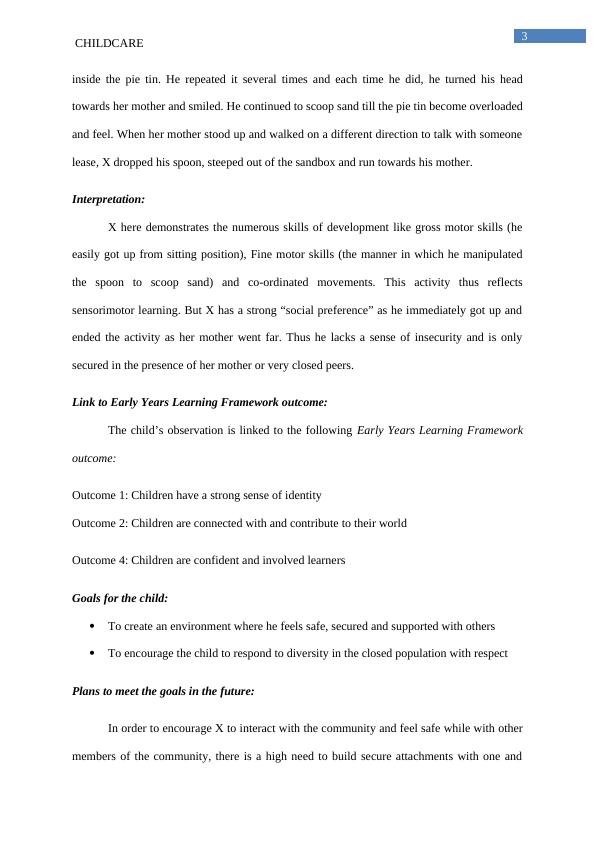Observing the Whole Child: Anecdotal Observations and Learning Stories
Added on 2023-06-15
14 Pages2959 Words232 Views
Running head: CHILDCARE
Childcare
Name of the Student
Name of the University
Author Note
Childcare
Name of the Student
Name of the University
Author Note

1
CHILDCARE
ACTIVITY 2: OBSERVING THE WHOLE CHILD
Hypothetical Child name: X (5 years old)
Anecdotal Observation
Anecdotal observations are short stories that are employed by the child educators to
note a significant incident that they have observed. The anecdotal records are easy to write
and demonstrate and are regarded as most popular form of record used by the educators.
1.
Observation 1:
X walked towards the climbing frame and place his foot over the first step but
stooped. He saw several other children lined behind him. He stood back and said them to go.
When all of them climbed up, X stepped again but immediately backed away when more
children arrived for their turn. X silently stood at the base of the frame for a while then
looked beside towards the painting easels and then walked towards it.
Interpretation:
By observing the child, it can be said that X is successful in applying the social skills
of turn taking and applies clear language skills to express his thoughts. However, X appears
to lack self-confidence while interacting with a small group of peers and also tend to select
solitary experiences. X also showcases the skill of decision making about her choice of
selective experiences.
CHILDCARE
ACTIVITY 2: OBSERVING THE WHOLE CHILD
Hypothetical Child name: X (5 years old)
Anecdotal Observation
Anecdotal observations are short stories that are employed by the child educators to
note a significant incident that they have observed. The anecdotal records are easy to write
and demonstrate and are regarded as most popular form of record used by the educators.
1.
Observation 1:
X walked towards the climbing frame and place his foot over the first step but
stooped. He saw several other children lined behind him. He stood back and said them to go.
When all of them climbed up, X stepped again but immediately backed away when more
children arrived for their turn. X silently stood at the base of the frame for a while then
looked beside towards the painting easels and then walked towards it.
Interpretation:
By observing the child, it can be said that X is successful in applying the social skills
of turn taking and applies clear language skills to express his thoughts. However, X appears
to lack self-confidence while interacting with a small group of peers and also tend to select
solitary experiences. X also showcases the skill of decision making about her choice of
selective experiences.

2
CHILDCARE
Link to Early Years Learning Framework outcome
The child’s observation is linked to the below mentioned Early Years Learning
Framework outcome:
Outcome 1: Children have a strong sense of identity
Outcome 3: Children have a strong sense of well-being
Goals for the child:
The following are the goals for further development of the child:
Encourage the child to engage in verbal and non-verbal communication with others
To provide support to engage in group activities with others
To explore her level of self-confidence and sense of personal well-being
Plans to meet the goals in the future
This goal can be achieved via engaging X in enjoyable interaction via employing both
verbal and non-verbal language. This will help in building of confidence among X. The
communication must be initiated first among the closed peers and then with among the peers
with who lies within the wider circumference This will be helpful for X because in sustained
communication with the children about creative and engaging ideas and experiences will help
to increase the horizon of their vocabulary and thereby helping them to gain confidence while
interacting with others in groups.
2.
Observation 2:
X was sitting inside a sandbox. In front of him there was a pie pan and he was holding
a wooden spoon in his right hand. He slowly scooped up sand with spoon and dumped it
CHILDCARE
Link to Early Years Learning Framework outcome
The child’s observation is linked to the below mentioned Early Years Learning
Framework outcome:
Outcome 1: Children have a strong sense of identity
Outcome 3: Children have a strong sense of well-being
Goals for the child:
The following are the goals for further development of the child:
Encourage the child to engage in verbal and non-verbal communication with others
To provide support to engage in group activities with others
To explore her level of self-confidence and sense of personal well-being
Plans to meet the goals in the future
This goal can be achieved via engaging X in enjoyable interaction via employing both
verbal and non-verbal language. This will help in building of confidence among X. The
communication must be initiated first among the closed peers and then with among the peers
with who lies within the wider circumference This will be helpful for X because in sustained
communication with the children about creative and engaging ideas and experiences will help
to increase the horizon of their vocabulary and thereby helping them to gain confidence while
interacting with others in groups.
2.
Observation 2:
X was sitting inside a sandbox. In front of him there was a pie pan and he was holding
a wooden spoon in his right hand. He slowly scooped up sand with spoon and dumped it

3
CHILDCARE
inside the pie tin. He repeated it several times and each time he did, he turned his head
towards her mother and smiled. He continued to scoop sand till the pie tin become overloaded
and feel. When her mother stood up and walked on a different direction to talk with someone
lease, X dropped his spoon, steeped out of the sandbox and run towards his mother.
Interpretation:
X here demonstrates the numerous skills of development like gross motor skills (he
easily got up from sitting position), Fine motor skills (the manner in which he manipulated
the spoon to scoop sand) and co-ordinated movements. This activity thus reflects
sensorimotor learning. But X has a strong “social preference” as he immediately got up and
ended the activity as her mother went far. Thus he lacks a sense of insecurity and is only
secured in the presence of her mother or very closed peers.
Link to Early Years Learning Framework outcome:
The child’s observation is linked to the following Early Years Learning Framework
outcome:
Outcome 1: Children have a strong sense of identity
Outcome 2: Children are connected with and contribute to their world
Outcome 4: Children are confident and involved learners
Goals for the child:
To create an environment where he feels safe, secured and supported with others
To encourage the child to respond to diversity in the closed population with respect
Plans to meet the goals in the future:
In order to encourage X to interact with the community and feel safe while with other
members of the community, there is a high need to build secure attachments with one and
CHILDCARE
inside the pie tin. He repeated it several times and each time he did, he turned his head
towards her mother and smiled. He continued to scoop sand till the pie tin become overloaded
and feel. When her mother stood up and walked on a different direction to talk with someone
lease, X dropped his spoon, steeped out of the sandbox and run towards his mother.
Interpretation:
X here demonstrates the numerous skills of development like gross motor skills (he
easily got up from sitting position), Fine motor skills (the manner in which he manipulated
the spoon to scoop sand) and co-ordinated movements. This activity thus reflects
sensorimotor learning. But X has a strong “social preference” as he immediately got up and
ended the activity as her mother went far. Thus he lacks a sense of insecurity and is only
secured in the presence of her mother or very closed peers.
Link to Early Years Learning Framework outcome:
The child’s observation is linked to the following Early Years Learning Framework
outcome:
Outcome 1: Children have a strong sense of identity
Outcome 2: Children are connected with and contribute to their world
Outcome 4: Children are confident and involved learners
Goals for the child:
To create an environment where he feels safe, secured and supported with others
To encourage the child to respond to diversity in the closed population with respect
Plans to meet the goals in the future:
In order to encourage X to interact with the community and feel safe while with other
members of the community, there is a high need to build secure attachments with one and

End of preview
Want to access all the pages? Upload your documents or become a member.
